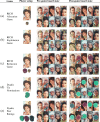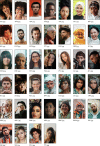DieTryin: An R package for data collection, automated data entry, and post-processing of network-structured economic games, social networks, and other roster-based dyadic data
- PMID: 34341963
- PMCID: PMC9046375
- DOI: 10.3758/s13428-021-01606-5
DieTryin: An R package for data collection, automated data entry, and post-processing of network-structured economic games, social networks, and other roster-based dyadic data
Abstract
Researchers studying social networks and inter-personal sentiments in bounded or small-scale communities face a trade-off between the use of roster-based and free-recall/name-generator-based survey tools. Roster-based methods scale poorly with sample size, and can more easily lead to respondent fatigue; however, they generally yield higher quality data that are less susceptible to recall bias and that require less post-processing. Name-generator-based methods, in contrast, scale well with sample size and are less likely to lead to respondent fatigue. However, they may be more sensitive to recall bias, and they entail a large amount of highly error-prone post-processing after data collection in order to link elicited names to unique identifiers. Here, we introduce an R package, DieTryin, that allows for roster-based dyadic data to be collected and entered as rapidly as name-generator-based data; DieTryin can be used to run network-structured economic games, as well as collect and process standard social network data and round-robin Likert-scale peer ratings. DieTryin automates photograph standardization, survey tool compilation, and data entry. We present a complete methodological workflow using DieTryin to teach end-users its full functionality.
Keywords: Automated data entry; Behavioral economics; Economic games; Peer report data; Social networks; Social relations.
© 2021. The Author(s).
Figures












Similar articles
-
What's in a name generator? Choosing the right name generators for social network surveys in healthcare quality and safety research.BMJ Qual Saf. 2012 Dec;21(12):992-1000. doi: 10.1136/bmjqs-2011-000521. Epub 2012 Sep 1. BMJ Qual Saf. 2012. PMID: 22942400
-
A Mixed Methods Approach to Network Data Collection.Field methods. 2014 Aug;26(3):252-268. doi: 10.1177/1525822X13518168. Field methods. 2014. PMID: 25285047 Free PMC article.
-
Name order effects in measuring adolescent social networks using rosters.Soc Networks. 2024 Jan;76:68-78. doi: 10.1016/j.socnet.2023.07.002. Epub 2023 Aug 9. Soc Networks. 2024. PMID: 37840904 Free PMC article.
-
Own-age bias in face-name associations: Evidence from memory and visual attention in younger and older adults.Cognition. 2020 Jul;200:104253. doi: 10.1016/j.cognition.2020.104253. Epub 2020 Mar 17. Cognition. 2020. PMID: 32192981 Review.
-
The difficulty with recalling people's names: the plausible phonology hypothesis.Memory. 1993 Dec;1(4):409-31. doi: 10.1080/09658219308258246. Memory. 1993. PMID: 7584280 Review.
Cited by
-
Social hierarchies and social networks in humans.Philos Trans R Soc Lond B Biol Sci. 2022 Feb 28;377(1845):20200440. doi: 10.1098/rstb.2020.0440. Epub 2022 Jan 10. Philos Trans R Soc Lond B Biol Sci. 2022. PMID: 35000451 Free PMC article.
-
Evidence of direct and indirect reciprocity in network-structured economic games.Commun Psychol. 2024 May 22;2(1):44. doi: 10.1038/s44271-024-00098-1. Commun Psychol. 2024. PMID: 39242753 Free PMC article.
-
Perceived inequality and variability in the expression of parochial altruism.Evol Hum Sci. 2025 Jan 20;7:e3. doi: 10.1017/ehs.2024.43. eCollection 2025. Evol Hum Sci. 2025. PMID: 39935444 Free PMC article.
References
-
- Bahrick HP, Bahrick PO, Wittlinger RP. Fifty years of memory for names and faces: A cross-sectional approach. Journal of Experimental Psychology. 1975;104(1):54. doi: 10.1037/0096-3445.104.1.54. - DOI
-
- Barthelme, S (2019). imager: Image Processing Library Based on ‘CImg’. https://CRAN.R-project.org/package=imager. R package version 0.41.2.
Publication types
MeSH terms
LinkOut - more resources
Full Text Sources

